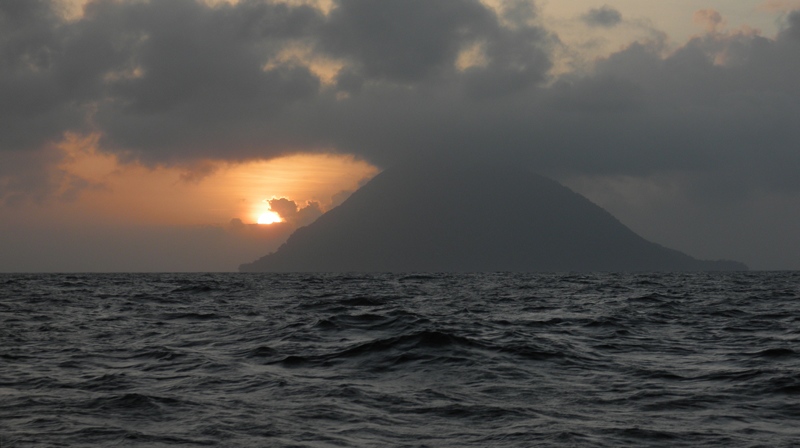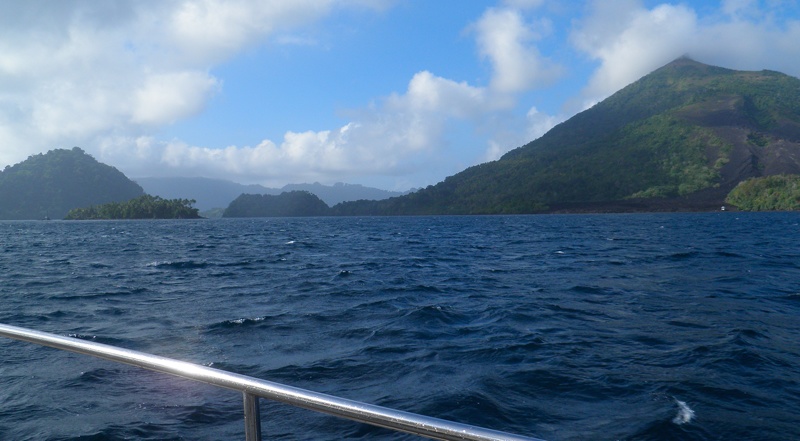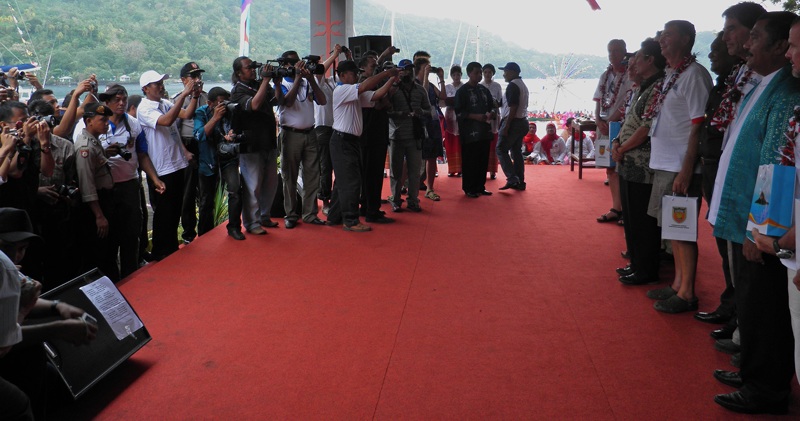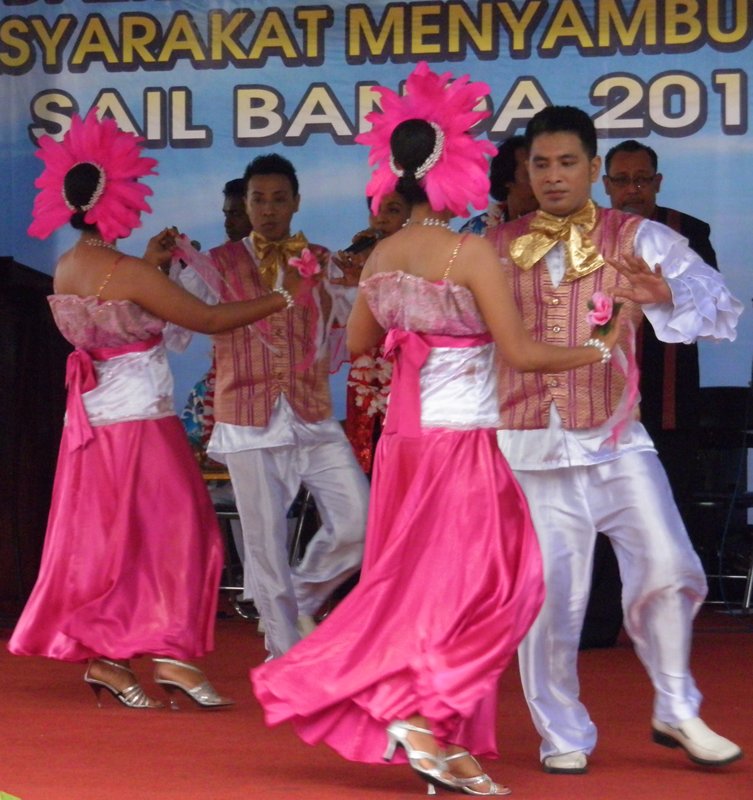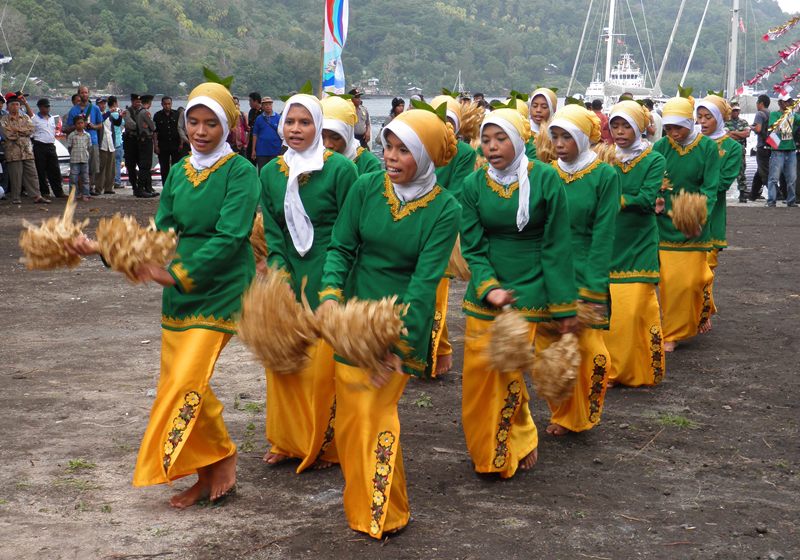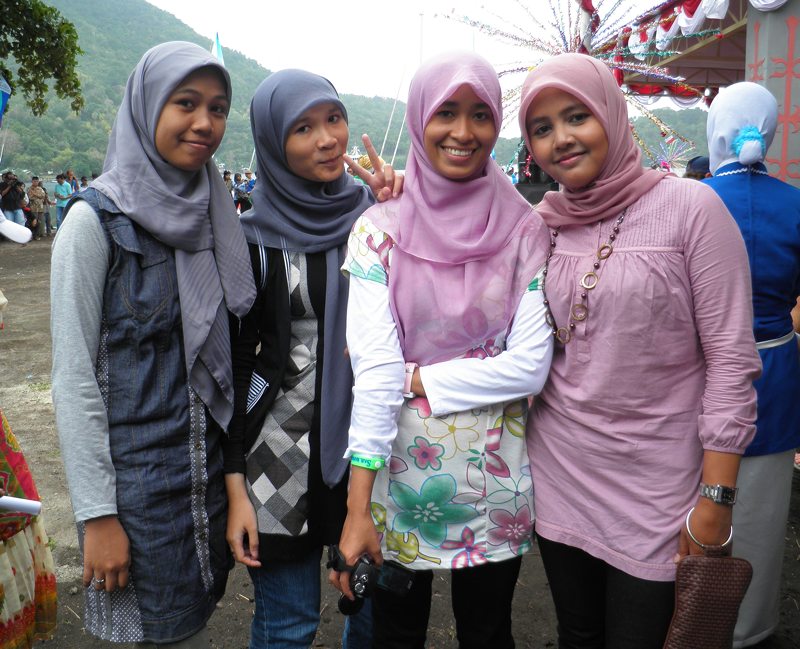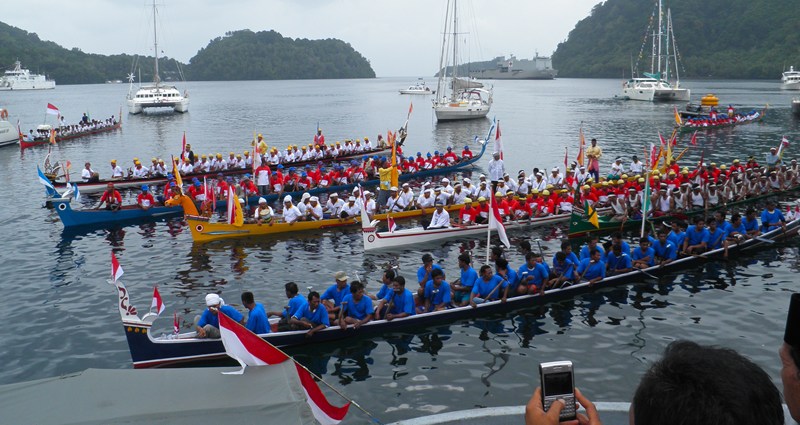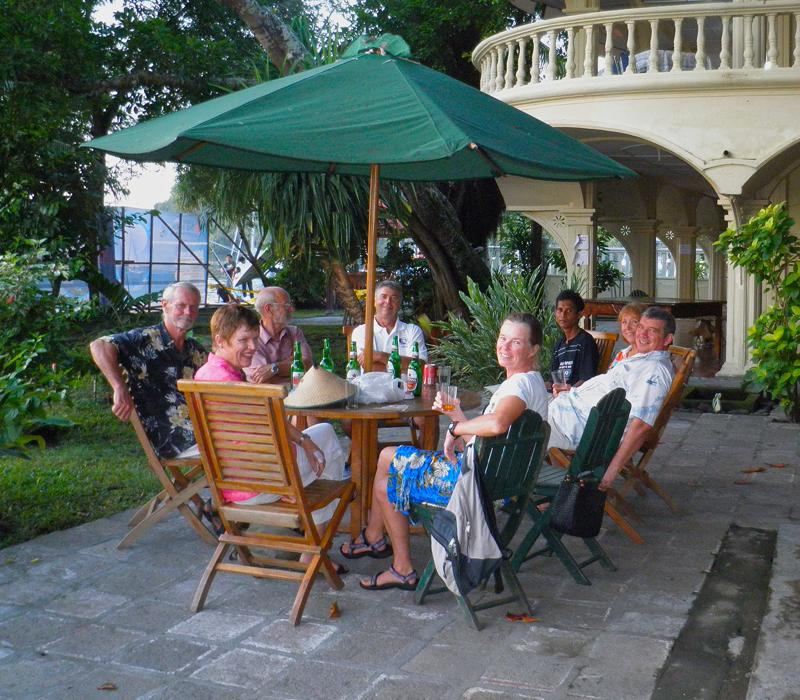Gobsmacked in Banda - Bandaneira, Neira Island, Maluku Province, Indonesia

Harmonie
Don and Anne Myers
Tue 10 Aug 2010 08:22
|
4:31.330S 129:53.848E
Ok! It's now August 9th, and so
much has happened in the short two weeks we've been in Indonesia, it's difficult
to boil it all down into some semblance of readable order. Maybe the place
to start is a little bit about Indonesia as a whole. Here are a
few fun facts:
Indonesia is the largest island nation in the world
consisting of 17,508 islands populated densely by 245 million people -
quite the opposite of Australia with its huge land mass filled
with only 21 million people.
The Indonesian archipelago stretches 2,700
miles from the Papua half of Papua New Guinea in the east to Sumatra in the
west, and sits on either side of the equator from 10 degrees south
latitude to 5 degrees north.
The median age of the Indonesian population is
27. Given the huge number of kids we've seen spilling out
from every corner of every town, a median age of only 27 is
easy to believe. We do wonder where all the pregnant women are
hiding? We haven't seen any.
Indonesia is the most populous Muslim nation in the
world. Generally, however, the form of Islam practiced here is
moderate. Most women and girls wear a headscarf and very modest
clothing not because it is required by law, but because it is their custom and
they choose to do so. Women are not sequestered in their homes, but are
part of the workplace and move freely in public. If it weren't for the
headscarves, head-to-toe women's attire, near-absence of
alcohol, and the call to prayer five times a day, we wouldn't even
know we were in a mostly Muslim country.
Now, about that call to prayer five times a
day...
It would be one thing if it was simply a call to
prayer. Or if it was a call to prayer from one mosque only. But it's
not. The call to prayer over the tinny mosque loudspeakers is always
followed by a prayer, and a chant, and a song, more prayer, more
chants, more songs, but not necessarily in that order. Often there are at
least three competing mosques, so three disembodied, sometimes whiney voices
float through the air directly into our anchorage and entangle themselves in an
Arabic mass of prayers, chants and songs. It's not as unpleasant as it
might sound, but it does cause a stir when it happens every morning at
4:15. We can say that we were saved by Allah in Banda though. There,
the early morning call to prayer happened at a more civilized 5am, and as usual,
woke us up. Shortly thereafter, the normally complete calm of the Banda
anchorage was ruffled by a brisk 15-20 knot breeze rolling through ahead of a
small rain squall. Not so bad except that it rolled through from a
direction 180 degrees different from the way all the boats were pointed.
Our boat swung toward shore with the fresh breeze and promptly bashed into a
giant (3 foot diameter) mooring buoy four other rally boats were attached
to. Thanks to Allah, we were already awake, so all we had to do was bolt
out of bed and throw some clothes on. After the interminable 10
seconds it took Don to fish a pair of clean underwear out of a locker, we jogged
up into the cockpit to survey the situation. Our dinghy had wrapped
itself around the mooring buoy and we were drifting to within touching
distance of one of the boats tied to the mooring. Don sorted
out the dinghy and started to bring up the anchor while I roved up and
down the port side of our boat with several fenders in hand, ready to
deploy them against the moored boat at a moment's notice. Of course the
Swiss couple on the moored boat woke up with all the commotion (or maybe Allah
also woke them up?) and jogged into their own cockpit to see me, a few feet
away with fenders in hand, wishing them a good morning. Yeah, not too
pleasant, but no harm done other than the ugly black streak the buoy left
on our starboard side (cleaned off by Don later that same day). We brought
the anchor up and moved further away from land, waited an hour for daylight to
arrive, and dropped the anchor in 45 meters of water (a new deep water
anchorage record for us). We then spent the remaining two or three days in
Banda praying to Allah not to bring any more brisk breezes because we
knew our anchor would drag due to the waaay less than standard 2-to-1 scope
we had deployed. It worked. The rest of our stay was
uneventful. Uneventful in regard to anchoring,
but certainly not uneventful in regard to anything else.
Picture 1 - One of the volcanoes we passed on our way from Darwin to Banda.
The sea in this area is extremely deep at 3,000 - 5,000 meters, so the full
height from the sea floor of a volcano like this one is probably 6,000
meters or 18,000 feet.
Picture 2 - Entering Banda Harbor.
Gunung Api is on the right, showing the black scar of its most recent lava
flow (it last erupted in 1988).
Picture 3 - Soon after we arrived, we were
handed a six-page invitation outlining all the planned events for the
following day. In true Indonesian fashion, the invitation was printed
beautifully on bordered paper complete with dignitary signatures
and several official-looking stamps. Not surprisingly, everywhere the
date, time and location of an event was specified in the
invitation, the information was pasted over with a new date, time
and location. Even so, the true date, time and location for most events
changed several more times after we received the pasted-over invitations, but
this is the charm of Indonesia. The morning of the main event, Don was
picked up along with the nine other chosen yachtsmen, and whisked off on a
ceremonial tour of the harbor. Meanwhile, the rest of us
less-special yachtsmen and women (there were about 25 boats in the
Banda harbor at the time) dinghied into the specified dinghy dock festooned
with ten 'Sail Banda!' banners to be greeted by a multitude of
adorable little boys all yelling "Hello Mister!" while they held
our dinghies in place and we climbed the rickety dock ladder.
Sometimes there was a "Hello Missus!" and once there was a very solemn
and well practiced "Good morning, welcome to Banda!", but mostly it was
"Hello Mister!" regardless of the boater's gender. Once ashore, we were
ushered down the street to the event venue (a stage and seating area newly
assembled for the occasion) by a series of young girls dressed in the
traditional Maluka long straight red skirt with embroidered hem and sheer white
blouse covering a white lace under layer. Gorgeous. All the
girls and women in Indonesia are genuinely pretty. It seems all the
Indonesian people are attractive - very slim with small frames, perfect
cocoa-colored skin, abundant black hair, dark almond-shaped eyes and giant
white smiles. Once we arrived at the seating area, we found a food package
waiting for us (several small cakes and a rice roll) and an elaborate glass
covered Sail Banda plaque made with letters carved from shells and housed in a
blue velvet covered case. In the short time we've been in Indonesia,
we've learned that nothing is under done - everything is elaborate and over
the top, blazing with color, texture and usually accompanied by a lot of noise
and a big crowd of people.
Getting back to picture 3...
The Banda Islands are a group of ten small islands
populated by about 15,000 people. We are pretty sure almost all 15,000
were crammed into the small town of Bandaneira for the festivities. We
believe this group of distinguished looking men is the Council of Elders
for the Banda Island community. They were certainly treated
with deference (as were we) and were seated in the 'primo' section
with the ten yachtsmen for the duration of the welcome show.
Picture 4 - Pauperatzi, Indonesian style.
After the ceremonial tour around the harbor, the ten yachtsmen were taken to
shore and officially welcomed by the local and regional dignitaries (even
the governor of the Maluku Province flew in for the occasion), and
given the Spice Islands version of a Hawaiian lei - 37 nutmeg nuts strung
together with large clusters of cloves and yards of red and white ribbons (the
Indonesian flag is red and white). In the picture, Don is on the right and
looks quite cool, calm and collected in the face of so many
cameras.
Pictures 5 and 6 - The
dancing. There was lots of dancing. Traditional and not so
traditional, but always with eye-popping, perfectly matched, fitted, pressed and
spotless costumes in an endless array of colors. Sometimes the girls
were dressed conservatively (picture 6), and sometimes not (picture
5). It should be mentioned that before the dancing, there were many
speeches. Many speeches. There was the local government
representative, and the Indonesian Minister of Fisheries and Marine, and the
Governor of Maluku Province, and the Regent of Central Maluku Regency (we have
no idea what this title means). All very proper and official. Oh,
and there was time out for prayer. Can't forget the call to
prayer.
Picture 7 - The girls. After the ceremony,
this group of four, like many others, was scrambling around taking as
many pictures of boring, white boater people as they could muster. After
we posed for them, they posed for us - looking lovely and fresh in their
head-to-toe covering despite the 85 degree heat and 80% humidity (you can bet we
looked bedraggled and wilted in the pictures they took of us). The peace
sign is big around here and most often seen when locals pose for
pictures.
Picture 8 - The start of the Kora Kora boat
race. The Kora Kora boats are replicas of traditional war
canoes. Each village has its own Kora Kora boat kept lovingly under a
special shelter near the water's edge, only taken out on special occasions
like the Sail Banda welcome ceremony for a race
around Neira Island. Kora Kora races are very serious
business as was indicated by the intensity of practice going on the
day before when we arrived in the harbor and had to dodge several of them.
These guys would put any crew team rowing down Boston's Charles
River to shame. Not to mention the fact that Kora Kora boats are much
prettier to look at and a lot more fun to listen to with their traditional drum
accompaniment and constant shouting. If you look closely at the upper
right-hand corner of this picture, you'll see the offending giant yellow
buoy we got to know so well during the early morning call to
prayer.
Picture 9 - After the welcome ceremony and the
start of the Kora Kora race, we were ushered down the road lined with smartly
uniformed military school students to the 'Culinary Show' - otherwise
known as a lunch buffet with enough dishes to feed all of us boaters, the
visiting dignitaries and many of the locals. Each table was equipped with
an English speaking local who proudly explained every dish. We went
for the papaya leaf salad and tuna kabobs and skipped the baked taro (a heavy
yam we grew to loathe when crossing the Pacific because it tends to sit like a
lump of lead in one's stomach for days following ingestion).
And that didn't end the festivities. That
night, a group from each of the surrounding villages performed their version of
a traditional dance. This event was set to start at 7pm, but due to rain
and a slow-to-arrive dignitary, didn't get off the ground until 9, but no one
seemed to mind. The dances ranged from the Cakalele (war) dance to
the nutmeg harvest dance, all set to music performed on traditional drums and a
gamelan, which is a series of brass pots filled with varying amounts of water to
create different tones not unlike a cross between the Caribbean steel drum
and a xylophone. That performance finished up at midnight and was
followed by an impressive display of fireworks. The next night brought
another dancing and singing performance during which we were seated up front
with the dignitaries and fed cakes and cinnamon tea while the masses (hundreds
of locals) looked on. In our travels, we have almost always been welcomed
warmly by the local people, but never like this. So far in Indonesia,
we have been treated like rock star royalty and it has just bowled us
over. We are gobsmacked. The people are so eager to please it would
be comical if they weren't so earnest. We believe part of the issue is the
bad rap Indonesia has as a result of the bombings in Bali and
Jakarta. That, and some civil unrest that happened in the Maluku Province
between the minority Christians and the Muslims back in 1999. The bombings
were caused by a few bag eggs and the civil unrest is now treated like a bad
dream to be forgotten. The Indonesians are working overtime to repair the
damage to their reputation as a country and a people. Fortunately or
unfortunately, we are benefiting in a big way,
Picture 10 - Talk about history. Sorry
for the length of this entry, but a blog about the Banda Islands
simply isn't complete without a look at the fascinating history of the
Spice Islands. As early as 1 AD, there is evidence that nutmeg and
cloves from the Banda Islands were traded with Arab, Chinese and Javanese
merchants, who then traded with European merchants. By the 15th
century, the spices were well known throughout Europe and more valuable than
gold, but the exact location of their source remained a mystery. It
was the Banda Islands, the only source of nutmeg in the world, that drove first
the Portuguese, then the Spanish, Dutch and English to seek the famed Spice
Islands by sea. One could say that the Spice Islands are the reason most
of the world ended up colonized by western Europe. Amazing to think that
could be true after visiting these tiny, remote, blameless volcanic snippets of
land. Anyway, the bloody Spice Island colonization history goes something
like this...
The Portuguese arrived in 1512 and established
several forts used to stockpile and guard harvested nutmeg and cloves. The
Dutch arrived in 1599, forcing the Portuguese out with their superior forces and
arms and built sturdier fortresses. Shortly thereafter, the English
arrived and played a cat and mouse game with the local Bandanese and the
Dutch over the next 200 years. Even with the English skulking about
in the background, the Dutch dominated, and ruled with an iron fist. In
1621, the then Dutch governor of the Banda Islands got angry with the local
Banadanese for trading with the English behind his back, and hired Japanese
executioners to exact revenge on the Bandanese. What followed was a
massacre, and many of the slain Bandanese were thrown down the well in this
picture, which is located near the center of the town of Bandaneira. Our
guide Sylvia (shown in the picture next to me) said the townspeople are still
reluctant to visit this place. We visited three Dutch forts on a couple of
the islands, one of which the Indonesian government completely restored in the
1990's. Although bloody and painful, the Bandanese are proud of their
Spice Island history, and the roots of it seem to be alive and well in
all of the people we met, including the kids. There doesn't seem to be a
lot of love lost for the Dutch, and there is great pride in the fact that
Indonesia won its independence from the Netherlands in 1949.
As a side note, there was a brief time in the early
1800's when the English had control of one of the nutmeg producing Banda
Islands. After some struggle with the Dutch, it was decided that the far
superior Banda Island would be traded with the Dutch for the low-potential
island of Manhattan on the east coast of North America. Turned out to be a
good deal for the English since they ended up with both Manhattan and enough
stolen nutmeg tree seedlings to start plantations on several of their other
tropical colony islands and ruin the Dutch nutmeg monopoly. Who said the
English weren't crafty?
History lives on in Bandaneira as the town is
chock full of Dutch colonial buildings and homes. Most are what the Lonely
Planet guide calls, 'moldering', but they are still standing and for the most
part, still used as businesses and homes. We took a walking tour of
Bandaneira with our guide Sylvia (an English teacher at one of the local high
schools), and then a boat tour around the nearby islands with another
guide. Not only did we stop at the base of the volcano's latest lava flow
for an incredible snorkel (the best since French Polynesia's Tuamotu Islands),
but we also visited a small plantation where nutmeg, cloves and cinnamon
are still harvested. History lives on through the spices
that continue to be exported. Unfortunately they are no
longer more valuable than gold, but they do bring in much needed income for
the area.
Aside from me, does anyone else not know that
cinnamon comes from the bark of a cinnamon tree? The bark! Who
knew? When harvested, the cinnamon trees are cut down and the bark peeled
off in thin sheets. Voila! Cinnamon sticks. We bought a whole
pack in the market for the equivalent of 20 cents. Now we are hooked on
cinnamon tea - a local Banda Island favorite served everywhere in place of
beer. When we toured the plantation, Don was hoping to find a money tree
in with the nutmeg, cloves and cinnamon, but it just didn't pan out. Maybe
our next Indonesian stop will reveal that mythical beast. In the meantime,
with Indonesian restaurant meals at only $5 per person, we may have
already stumbled upon one version of a money tree.
Picture 11 - Last, but not least. Bintang
beers all around at the one and only 'fancy' hotel in Bandaneira.
Starting from the left and going clockwise, that's Sue, Tom from American
boat Priscilla, John, Don, Magga, our boat tour guide (drinking Coke, not beer,
mind you), Robin and Barry (Storyteller guests) and Suzy from
Priscilla.
And that big blast of words only covers our first
stop and first five days in Indonesia. More adventure stories to
come covering our stops in Ambon and Wakatobi.
Anne
|
